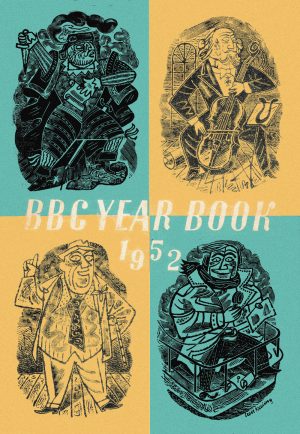Television for younger viewers
A look at BBCtv programmes for children in 1951

‘Nothing offends children more than to play down to them. All the great children’s books — the Pilgrim’s Progress, Robinson Crusoe, Grimm’s Fairy Tales, and Gulliver’s Travels — were written for adults.’ Bernard Shaw

Since September 1950 boys and girls from the ages of five to fifteen have had their own daily programme from their own studio in Lime Grove, and parents have only themselves to blame if they allow more than this reasonable ration. The very first week produced amazing evidence of the younger generation’s readiness to adopt 5 to 6 p.m. as theirs: the ‘Telescope’ general interest magazine programme received 6,000 entries for its first competition and conundrum, whilst its variety companion, ‘Whirligig’, discovered no less than 1,200 young dramatists, who in one week sent in plays for ‘Write it Yourself’, a thrilling serial acted by professionals and kept going over the months by children creating the scripts themselves.
British children are not made lazy by television. From north to south they obviously enjoy participating in programmes — in music, singing, writing, acting, debating. Especially encouraging is the standard of child art.
Our first task was to establish a daily programme starting with such items as puppets for the very young and working up robustly in the age groups. For the older children the scheme was this: Sundays — plays; Mondays — films of adventure (Renfrew, Rex and Rinty, Mystery Squadron); Tuesdays — dramatized books; Wednesdays — story-tellers, travel, cartoonists, countryside, ballet, careers, books, art, music, history, discovery, quizzes; Thursdays — documentary; Fridays — sport; Saturdays — magazine programmes.
There is a huge untapped source of material waiting to be opened up for children and adults with children. What more endearing families could be seen in your own home than the Louisa Alcott Little Women, or E. Nesbitt Railway Children, poised and natural and resourceful, or the naughty boys of Just William. The child of today is keenly conscious of the world he lives in and the part he has to play in it in a way preceding generations were sheltered from. He or she is frank and natural — with discussion as ‘Junior Wranglers’, or histrionics when they ‘Play the Game’.

Experiment has been the keynote of this first and formative year of regular visual entertainment and information for children. Experiment in specially written plays (Gunpowder Guy), experiment in specially dramatized novels (Treasure Island, The Malory Secret), simple ways of presenting Shakespeare (A Midsummer Night’s Dream and The Tempest), experiment in animations, in use of transparencies and shadows for fairyland effects. None of this would have been possible without the enthusiasm of young producers who have thrown themselves so whole-heartedly into the work.
One play specially commissioned, The Little Swan, showed the struggles of a young girl to earn enough in a pantomime chorus to pay for her classical dancing lessons. This provoked a small child into begging for a sequel. After the success of The Powder Monkey in company of no less than Nelson and Hardy at Trafalgar, we soon discovered the need for further adventures for the same boy as Midshipman Barney.

As a contribution to the Festival of Britain, Children’s Television invited over two French children as their guests for three weeks. This is a prelude to a larger plan to send two children (with a cameraman and chaperone) right round the world, so that every child everywhere will effectively go with them on the grand tour and see children of other lands through the eyes of children.

Children’s television has deliberately set out to build up personalities children now know and like — Humphrey Lestocq (‘H. L.’), Bruce Gordon (The Man in Armour), Valerie Hobson with her ‘How to’ needlework, Robert Morley (‘Parent-craft’), Harold Glover (‘Men of Action’), Annette Mills, impeccable in her technique at the piano, Doris Langley Moore, with her authentic costumes of other periods, Richard Hearne (Mr. Pastry), ‘Fish-Hawk’ and Percy Edwards in ‘Nature Calendar’; Harry Rutherford, moving about with his ‘Sketchbook’ and his novel ‘Book Bag’ reviews, Cliff Michelmore, ubiquitous in sport, Barrie Edgar, out on the O.B.s, Peter Madden, who in his time has played many parts, Peggy Cameron (‘What’s the Object?5), Hugh Gee, the story-teller, and the charming trio of young announcers Jennifer Gay, Janette Scott, and Elizabeth (‘Your Puppy5) Cruft. There are the ‘Immortals5, the Reluctant Dragon, the veteran Muffin, Mr. Turnip, Hank, Dudule the Duck, Timothy Telescope, Cactus the Camel, Prudence Kitten, Daisy May, Matilda Mouse, Cyril the Centipede, Dash and Dither, Johnny Chuck and Grandma, Vegetable Village and Cuthbert the Camera.

Among the newer presentations are Kipling’s Puck of Pook’s Hill, Mrs. Frances Hodgson Burnett’s Sara Crewe, Noel Streatfeild’s The Bell Family, Billy Bunter and the ‘Grey-friars’ school stories, Arabian Nights, Hans Andersen’s life, Sherlock Holmes, Emil and the Detectives, At your Service, Ltd., John at the Fair, and a series on the boyhood of the Great.
In my view the television children of today are lucky, for he and she, given the best acting, good design, expert advice, and high standards in presentation will be helped to reject for themselves the second-rate in their life to come.
About the author
Cecil Charles Madden (1902 – 1987) was a BBC executive.




BBC also showed episodes of The Cisco Kid + The Range Rider, during the early 1950s between 5 and 6pm. Francis Coudrill`s Hank the Cowboy series was produced in colour. An excerpt from The Powder Monkey was featured on the morning demonstration film, hosted by Jennifer Gay.